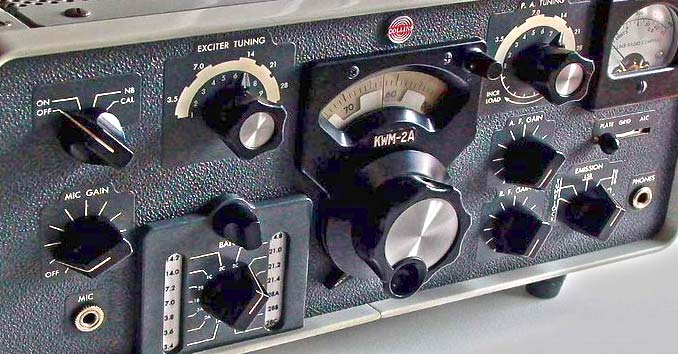
Emergency Communication is probably one of the least talked about aspects of preparedness, but in my opinion, it plays a vital role in ensuring your survival during any disaster and is something that you can’t afford to overlook.
Disaster after disaster has shown us how crucial communication can be during a time of crisis. From dispatching first responders into affected areas to coordinating with loved ones during times of crisis, our communications infrastructure is essential to our safety.
Unfortunately, while we have made great strides in communication technology, our infrastructure is incredibly vulnerable to even small-scale disasters and storms. Time after time we’ve seen our cell networks fail, our modern devices stop working and even our 911 systems overloaded during periods of crisis.
Are You Prepared to Reach Your Family During a Disaster?
Just like all areas of survival, the first step in emergency communication is preparedness. That means developing an Emergency Communications Plan, and then making sure everyone in your family knows what it is, and how to put it in place during a disaster.
- Make a list of who you will contact during a disaster. Everyone in your family, or your group, should have that same list.
- Your Emergency list should contain phone numbers, email addresses, and even social media networks.
- If possible, you should have a local contact and 1 – 2 contacts that are out-of-state. These people should be agreed upon before a disaster, so your family can use them as the point of contact during a time of crisis.
- Your Main Point of Contact can then coordinate either evacuation efforts, or efforts to reunite members of your family or group.
- Once disaster hits, and you have removed yourself from harm’s way, one of your first priorities should be making contact with your emergency contact list. All plans, follow-up contacts, schedules and status updates should then be relayed to your entire emergency contact list. This means reaching your point of contact first, and if possible shooting out a mass email & text message to your list and updating your social network status.
Emergency Communication Gear & Options
During a disaster, it’s very likely that most communication channels will go down. Hopefully it’s only temporary, but either way, you need to plan for the worst case scenario and have multiple options available.
CELL PHONES
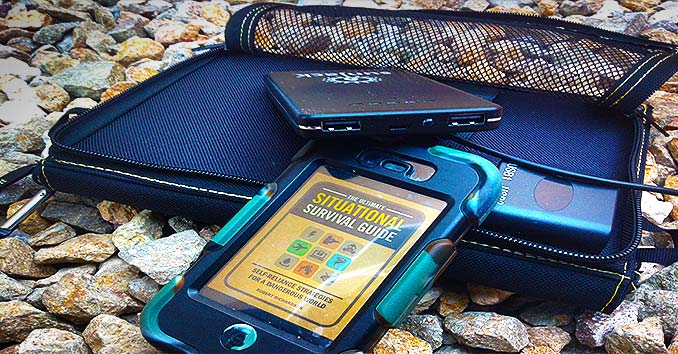
We will start with cell phones because almost everyone has one. While cell networks are often overwhelmed during a disaster, they’re going to be your first line of communication. Even when things are bad, they still might help you make contact.
Even when things are bad, don’t panic; they still might help you make contact. If your initial attempts to make a call fails, try texting or using your phone’s data plan to make contact.
As we’ve seen during many past disasters, texting and even social media apps can sometimes work, even when voice calls stop going through. A text message takes a lot less bandwidth, so during a disaster, this might be your best bet for making contact.
SOCIAL NETWORKS
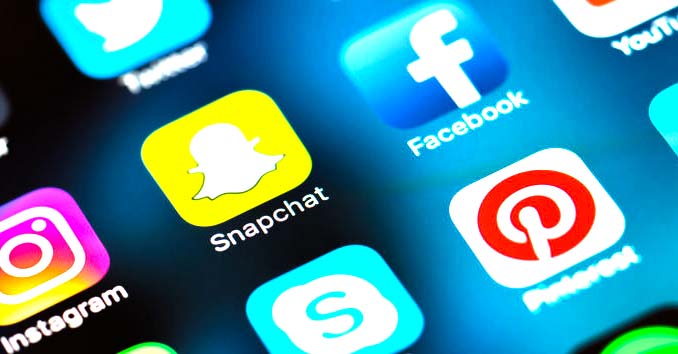
While you’ll still need some way to access them, social networks can be a great way to communicate during a disaster. If you can make your way to an emergency crisis center, or access them on your cell phone, you may be able to post a status update to your social networks.
While I wouldn’t rely on this as my primary means of communication, it can be an excellent way to let friends and family know you’re ok, or let them know what you’re planning to do next.
SATELLITE PHONES
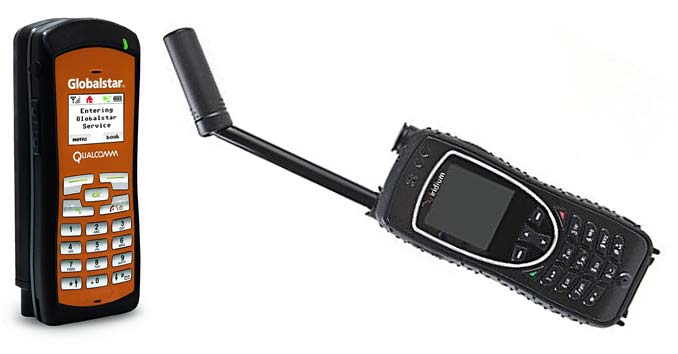
While on the expensive side, during a natural disaster or crisis, these types of phones can save your life.
Satellite phones offer a couple of advantages during a disaster. First, they don’t rely on local cell networks, so they’re less likely to be affected by an increase in call volume. Second, even if the entire local cell network goes down, your satellite phone is still going to be operational.

Recently I’ve been testing the SPOT Global Sat Phone, and I’ve been really impressed with its ability to call from even the remotest areas of the backcountry. In areas where my cell phone had zero reception, my SPOT phone worked and was able to call anywhere in the world.
CB RADIO
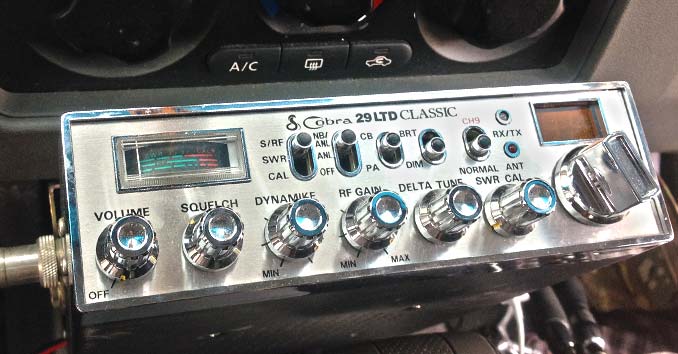
I know, you’re probably picturing big rig trucks or bad movies from the 1980’s; but the fact is, the C.B. Radio can be an important part of your emergency communications arsenal. I recommend having one in your vehicle, having a handheld one in your bugout bag, and having a base station at home.
During a localized disaster, you should be able to make contact within a 20 – 30-mile radius. This makes the CB Radio a great way to coordinate with friends and family during localized disasters.
FRS/GMRS Two-Way Radios
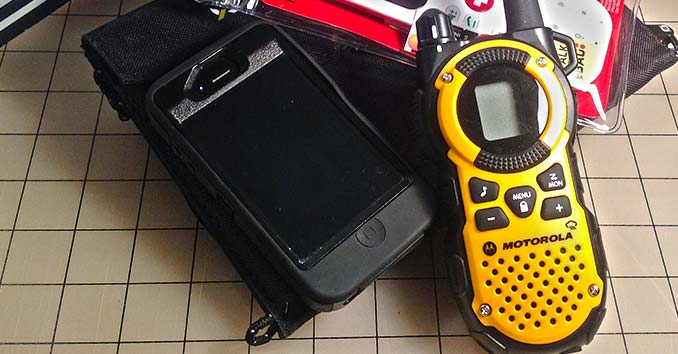
The Family Radio Service (FRS) and The General Mobile Radio Service (GMRS) are both designed for short-distance two-way communication. They’re generally used with small walkie-talkie devices and have a range of somewhere between 5 to 35 miles (line of sight) and about 1 mile in an urban setting.

I use the Motorola MS350R Talkabout and recommend them for caravanning or when hiking in groups.
HAM RADIO
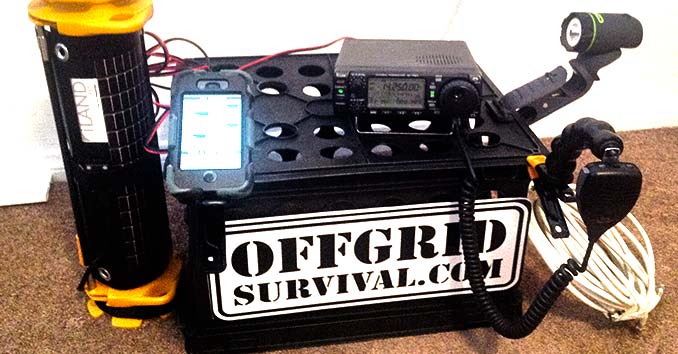
Having and knowing how to use a Ham Radio is probably one of the most important things you can do to ensure your ability to communicate during a disaster. For over a hundred years, the Ham Radio has played a vital role in almost every major disaster this country has faced.
When the grid goes down, the cell networks stop working, and every other line of communication fails, there’s a pretty good chance the Ham Bands will be alive and operating. Just remember to have a set list of frequencies where you and your group will try to make contact.



There are several smart phone apps that only need internet access. Also, with a Hughesnet Satellite internet account, you could also mount it in a very remote area, and still have satellite internet, phone, etc.
Hmm.. cell phone apps are good… UNTIL the battery runs down and there is no way to recharge the device. Time to rolll out the solar charging options that are becoming more available these days… still
Or hand crank. I have a hand crank radio with a USB charger port
When SHTF I think the DHS/DOD will shut down cell phones and/or jam and/or radio locate Ham Radio transmissions, GMRS, FRS, CB, and any other communication means for civilians. I think I need a radio scanner to monitor Federal and Local Police communications to know when their goons are coming to my neighborhood to confiscate my guns and emergency supplies and try to send me to the FEMA camp if I survive that. I need to know about what type of radio scanner to invest in and what frequencies and communication modes to monitor so that I won’t be surprised in the middle of the night when my door is smashed down. I found the Federal National Interoperability Field Operations Guide published by DHS that lists many of the communication channels but I suspect they do not publish the secret channels. Someone suggested to me on a RadioReference Forum that the DHS communication will be on 666.6625 MHz with digital encryption and even provided the encryption key. I have no way of verifying that. Either that person was spoofing me or he must be a DHS insider. Any suggestions would be appreciated.
SHTF Commo would be best using trusted-friend “neighborhood-watch” groups with binoculars and code-signals to alert you. Yes, radio (All frequencies) will more than likely be jammed and monitored. Mirrors, fireworks and flashlights used properly can signal others in your group. Pre-arranged code-words are a must if using short-range radios. Remember the 7-P formula (Proper Prior Planning Prevents P___ Poor Performance!
Just an FYI, most Federal and Local Police now used Trunked radios with encryption. Most scanners no longer have a way to listen in on them anymore. Still not a bad idea.
As far as Ham Radio’s go, chances are they will be used for disaster relief by the local Hams under the ARES organization. So chances are, the bands will not be jammed. Plus if you get onto the HF frequencies it would be hard to jam every frequency, and most hams know how to get their radios to work out of band, thus if the government were to shut down, you could potentially operate outside of the normal ham bands. It would be too difficult to monitor all the frequencies.
CB would be easy to jam since they operate on fixed frequencies, so if the Government is out to control the population, this will be the first to jam along with GMRS and FRS. they are still good to have just in case the government isn’t controlling things.
I can tell you the DHS has communication trucks already stationed around every major city designed to be their own personal cell towers. I work for a large fire department and there is a truck in one of our stations that is part of the FEMA Urban Search and Rescue teams. We are told that we can pull it out to wash the bay floors and back it in. The thing is locked up tighter than fort Knox. Makes you wonder what else they have that is hidden even further
You will not be able to monitor most emergency communication with a scanner because much of it now is encrypted. Plus, you jumped all over ham radios based obviously on social media reports, or you would know that they can also be used to monitor (but not talk on) the same emergency frequencies for which you would pay much more to hear on a scanner.
CB Radio’s went the way of the do-do bird and the 8-Track. People now use FM Radios with more broadcasting power than the General Mobile Radio Service (GMRS). Still basic line of sight.
GMRS radios require a 5-year license from the FCC. If you get caught using GMRS band without a license, it is (up to) a 10k fine–which I am sure the Gov will love to impose on anyone. CB is more practical and has longer-range with the proper antennas.
The problem with CB is the power limitation. Honestly, go get your Ham Radio license. If a 9 year old can do it, then so can you. Then it gives you the freedom to run more power, more frequencies, and allows you to operate out of band if the situation arises. CB is not actually making a come back. Most truckers are now getting their Ham License because it’s easier to find decent people to talk to rather than foul languaged people, plus it offers greater distance if you go into the HF range. Plus gear for CB is harder to find these days.
Don’t be lazy, get your license.
Actually around the time I was first licensed I remember reading about a 5 year old that passed his test, and this was when they required a 5 wpm code test and the answers to the tests were not made available beforehand
I’m in northern Maine and cb works much better than frs / gmrs. I’ve talked to Alaska, Florida, Texas, most of the mid-west, as well as Ireland and England. Don’t rule out cb for good comms, as long as you have a decent radio and good antenna.
Cb s are definetly making a come back…pay extra and yourself SSB
We’ll worth it
Also look at i355 iden phones on the talk around mode instead of frs gmrs they are encrypted and are digital clear…..
What about marine radios, they are built to be weather proof and use a different band width than land use cb’s.
One of the most important items that we use is a county by county map (available at your local state road dept.) we also change the log and lan to make it difficult to locate us, just in case.
My Emegency channel is 12.
The first choice for 2 way comms should be a CB with SSB. The second choice should a HAM radio which will utilize frequencies from 30Khz to 30Mhz including the ability to monitor the world shortwave frequencies for news and radio monitoring from the entire planet. All that is needed is a long wire for receiving broadcast news. Remember as long as you don’t transmit you can’t be located. If you do transmit keep transmissions short and infrequent. Set up check in times ahead of time which can be verbal or just a couple of mic clicks to signal ok or distress. Most law enforcement agencies have switched to digital 800Mhz which requires a newer scanner which are pricey but well worth the money if you need to know what is going on in the LE world. The FEDs will disable cell towers and internet but cannot stop 2way radio except with a jamming signal which effects are limited to local areas. CB radios are not line of sight like GMRS and FRS and cell phones. The older HAM radios are versatile and easy to use, digital communications is also possible with the newer models as well as sstv.
Thanks,,great info.
I have both a mobile 100 watt ham fully portable with power and solar as well as a 5 watt quad, both with mars/cap. with my Yeasu VX7 I have already found and set in memory all the local LEO freq. and listen all the time, I carry it everywhere as I have my license, during my last road trip I did scans and picked up and memorized the frequencies for SC, NC, GA AND FL successfully (all major cities I passed through, I believe I even got the GA and FL State troopers. Marine radio is just VHF set said on special spectrum of the frequencies, but the rubber duck antenna that comes with those limits your range A LOT, if you buy a VHF marine radio that you can replace the antenna on, DO IT, it will increase your range by double or more. I can get 50+ miles from my little hand held and out of my back pack rig I have talked to mexico city and porto rico. its all in the antenna
They say the an EMP blast will disable all mechanical equipment – regardless of what it is – best to have a plan and stick to it the best you can – meet here – if we can’t get there – wait this many hours and then go to the next local.
I am ah licensed Ham to start with.
I have 2m and 70cm for short range and 10m radios for reaching out.
I can make antennas out of just about anything but have antennas for all my radios and a solar backup power supply for all of them at the same time.
Dr. Bill,
I have experience with long range radio in the USMC 1972-1976.
However I know almost nothing about Hamm operations. Where can I start to learn about HAMM Radio OPS?
Thank You Sir
Cahill, uh rah, check the ARRL website for local Amateur (HAM) clubs. Some clubs hold free classes for the 3 llicense levels. Also, ARRL sells the study guides for the different levels. There are APPs you can use to take practice test on line. Good luck. Semper Fi
When purchasing 2-way radios like the GMRS/FRS units, don’t get the ones with rechargeable batteries unless you have a sure-fire way to recharge them. If the power grid goes down and you don’t have alternative power sources they will be useless.
Most of those take double a or triple a also.go to dollar tree buy solar patio lights for a buck… these have triple a batteries and a solar charger and double as a light source..all for a dollar.I have found other solar patio lights that have double a batteries also..
I really have a great desire to comment in this subject area, but I don’t want to initiate a debate that is nonproductive. But, I have a desire to add some information.
“Watcher” is partially correct. During ANY disaster the telecommunications network will all but shut down. That is aimed at preventing a massive number of people clogging up the networks with calls from people, usually Grandma so-n-so or Aunt so-n-so, wanting to know if little Billy is OK. Unless one has “the special pre-dial number” (which I have several of) that will allow calls to go through. During Hurricane Katrina there were over 6 million attempts to call people in New Orleans. Can you imagine how many calls that had actual importance would have gotten through if the 6 million had been allowed to complete? Think about that. The little that got done during Katrina would have been ZERO if all the “little Billy” calls had gone through?
GMRS/FRS/MURS and all the other “services” will be almost useless during a real disaster. Why? How many of those radios have been sold? How many frequencies do they have access to? Divide number of frequencies by number of radios and you have a probability on usage that is almost zero. Throw in the Children’s Band radios and the probability might get to one.
Amateur radio can and will rate up into the 40-50’s for ability to communicate. i.e., 40 to 50% of the time communications is needed it can be accomplished. The biggest problem is what frequency will the needed communication take place? The few groups that are actually organized in what takes place on what frequency on what day and at what time are unbelievably few.
There are a large number of people talking about how “far” HAM radio can talk, but few on how efficiently HAM radio equipment can used in a large disaster scenario. VHF/UHF can work well for short range communications, specifically station-to-station and low power. But, in a EMT/CME/power Down scenario, no repeaters, the best to be expected is maybe 10 miles, unobstructed. Ground-wave HF around 50 miles, vertical polarization. D,E, and F regions (day time hours) from 90 to 200 KM. Ionosonde operation around 20 to 90 KM. This cannot be accomplished without different antennas.
OBTW……”jamming” of radio frequencies, presently, is not something that has a high probability of being done. 1: Too much trouble. 2: Why?
Now let’s throw in ionization effects. With a EMP or CME the ionosphere will be charged up (excess electrons doing nothing but absorbing RF and other useless things) and will not allow RF communications to go anywhere. Closure in to this planet the ability of RF energy to propagate beyond ones nose will be greatly reduced. This have been observed several times from some nicely charged particles from CME’s.
So, what is the solution? Why doesn’t OGS come up with a “calling frequency”. Suggest some frequency, say on 15 meters, maybe 20, for those of us that hang around here to initiate communications on. From there we can QSY to a frequency to talk on. Might even set up a UHF and VHF frequency for a calling Freq. OMG!!!! ORGANIZATION. What are we doing? LOL
My Personal opinion……stay away from the WalMart, Kmart, Costco junk radios. Get a HAM license, get a real radio, and get on with real communications.
My apologies if I sound biased. I AM.
hawkeyes, 40+ years in radio stuff
I did 30 years as an EW guy in the military. I am also a FEMA instructor trainer (I train the instructors) in continuity of govt/disaster relief. What Hawkeyes said is pretty accurate.
For those of you worried about the govt “jamming” communications or tracking you, in a true SHTF scenario (which in an EMP event it will be) you give too much credit to the men in black helicopters. Jamming is highly environmentally and equipment sensitive. The military and fed govt just isn’t set up to try to disrupt people inside CONUS, nor would they want to. Instead, just like Katrina, they will rely upon the Ham network (if available) during a major event to back up or replace the regular comm lines.
If you haven’t done any research on Faraday cages and how to build them to protect your gear, you need to get started. http://www.dailymail.co.uk/sciencetech/article-3844720/Are-risk-solar-storms-Map-reveals-Minnesota-worst-hit-blasts-knock-power-millions.html is a link to EMP data Here is a discussion on Faraday cages and a link on how to build small ones. You could use a 18 wheeler shipping container for a big one. http://modernsurvivalblog.com/emp-electro-magnetic-pulse/what-to-store-in-a-faraday-cage-for-emp-protection/
The very best solution is SPOT Gen3 GPS satellite for
$ 150.00 you can send short text messages from the other side of world. will connect to you loved ones e-mail or phone text messages. Check out video reviews on You Tube.
Quick question. Would not licensed HAM users be easy to find since they require a license and probably gave their personal information to get the license? I think this would be an easy way for gov to track equipment and a prepper.
You are correct. In fact, anyone can look up my ham radio license information (when the internet is working) but it would be much harder to do if all the electronics were down.
hi people. I haven’t read all the comments so apologies if this has been covered.
electronic Communications during a major disaster, common, its really time peole start getting serious about this stuff.
Any time we have a festival or a massive bush fire in Australia the phone networks crash to to begin with .
Make your plans, do your communication with those relevant people prior to any drama. The only communications you should do is face it face or written and left in pre arranges spots in the wilderness if necessary.
forget gps, learn to navigate with a map and compass, or the sun.
please people, think outside the box here, simplify, plan effectively before anything happens, communicate, practice, refine and be ready. “PPPPPP” “prior preparation and planning prevents piss poor performance”. good luck!! :D
I would also add Marine radio to the list of devices to communicate if you live near the coast or have a boat
Get a kiddie pool and fill it with water. Then get an inflatable raft and sit in it and float in the kiddie pool with your VHF Marine setup. I would bet that technically this qualifies as a boat and keeps marine VHF legal on “land”.!
I think you better check again regarding the idea that if you only listen, you can’t be found. Most modern receivers use an intermediate freq of 455 kc. The circuit that generates that freq also produces the freq as a radio frequency. The Germans in WWII were able to find radio sets to great success just by direction finding of the 455 kc frequency. You could always use a crystal set, but you are limited to close and high power AM frequencies.
What will I do if I have no means of communication at all?
Stand with your legs shoulder width apart, bend over and grab your ankles. ….kiss your *** goodbye.
You can still make a Globalstar to Globalstar call even if everything is decimated. Should wheat fields in Canada prevail, then more than likely you will be safe!
Sure beats Iridium. Last month I tossed mine into the Gulf of Mexico to join the rest of the trash on the ocean floor. That Iridium service is horrendous these days. Of course this is 2 years removed when one dealer told me of course you can browse the internet with iridium! At 2400 baud.! No less! Anyone watched the fate of William Wallace? Thats the same feeling you will get when hemmoraging the Iridium system with its so called dayta.
Globalstar satellite phones (which work like a swiss watch these days!) are now FREE. So all you have to do is pay for the service. In fact, a really nice dealer in Vancouver, Ms. Lynai Briggs threw in 2 extra batteries just in case! Her tel 3609102693. lynaiglobalstar at gmail dot com . She was top notch to deal with.
Im out!
Bryce
Think back a hundred years ago and how our grandparents did things
My daughter is 22 years old and her apartment is a bit off the beaten path, I worry about her and I am wondering if there is something out there that she can wear like a necklace or watch that acts like a mobile panic button?
Watch what you are saying ears are everywhere